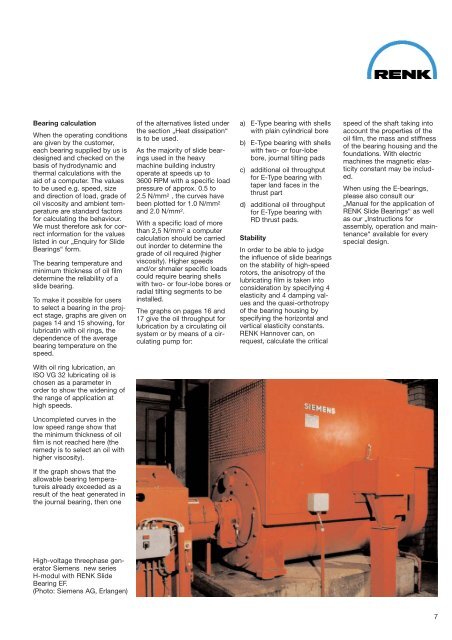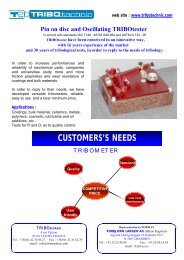Slide Bearings Type E For Shaft Diameter Range 80-355 mm Main ...
Slide Bearings Type E For Shaft Diameter Range 80-355 mm Main ...
Slide Bearings Type E For Shaft Diameter Range 80-355 mm Main ...
You also want an ePaper? Increase the reach of your titles
YUMPU automatically turns print PDFs into web optimized ePapers that Google loves.
Bearing calculation<br />
When the operating conditions<br />
are given by the customer,<br />
each bearing supplied by us is<br />
designed and checked on the<br />
basis of hydrodynamic and<br />
thermal calculations with the<br />
aid of a computer. The values<br />
to be used e.g. speed, size<br />
and direction of load, grade of<br />
oil viscosity and ambient temperature<br />
are standard factors<br />
for calculating the behaviour.<br />
We must therefore ask for correct<br />
information for the values<br />
listed in our „Enquiry for <strong>Slide</strong><br />
<strong>Bearings</strong>“ form.<br />
The bearing temperature and<br />
minimum thickness of oil film<br />
determine the reliability of a<br />
slide bearing.<br />
To make it possible for users<br />
to select a bearing in the project<br />
stage, graphs are given on<br />
pages 14 and 15 showing, for<br />
lubricatin with oil rings, the<br />
dependence of the average<br />
bearing temperature on the<br />
speed.<br />
With oil ring lubrication, an<br />
ISO VG 32 lubricating oil is<br />
chosen as a parameter in<br />
order to show the widening of<br />
the range of application at<br />
high speeds.<br />
Uncompleted curves in the<br />
low speed range show that<br />
the minimum thickness of oil<br />
film is not reached here (the<br />
remedy is to select an oil with<br />
higher viscosity).<br />
If the graph shows that the<br />
allowable bearing temperatureis<br />
already exceeded as a<br />
result of the heat generated in<br />
the journal bearing, then one<br />
High-voltage threephase generator<br />
Siemens new series<br />
H-modul with RENK <strong>Slide</strong><br />
Bearing EF.<br />
(Photo: Siemens AG, Erlangen)<br />
of the alternatives listed under<br />
the section „Heat dissipation“<br />
is to be used.<br />
As the majority of slide bearings<br />
used in the heavy<br />
machine building industry<br />
operate at speeds up to<br />
3600 RPM with a specific load<br />
pressure of approx. 0.5 to<br />
2.5 N/<strong>mm</strong>2 , the curves have<br />
been plotted for 1.0 N/<strong>mm</strong>2 and 2.0 N/<strong>mm</strong>2. With a specific load of more<br />
than 2,5 N/<strong>mm</strong>2 a computer<br />
calculation should be carried<br />
out inorder to determine the<br />
grade of oil required (higher<br />
viscosity). Higher speeds<br />
and/or shmaler specific loads<br />
could require bearing shells<br />
with two- or four-lobe bores or<br />
radial tilting segments to be<br />
installed.<br />
The graphs on pages 16 and<br />
17 give the oil throughput for<br />
lubrication by a circulating oil<br />
system or by means of a circulating<br />
pump for:<br />
a) E-<strong>Type</strong> bearing with shells<br />
with plain cylindrical bore<br />
b) E-<strong>Type</strong> bearing with shells<br />
with two- or four-lobe<br />
bore, journal tilting pads<br />
c) additional oil throughput<br />
for E-<strong>Type</strong> bearing with<br />
taper land faces in the<br />
thrust part<br />
d) additional oil throughput<br />
for E-<strong>Type</strong> bearing with<br />
RD thrust pads.<br />
Stability<br />
In order to be able to judge<br />
the influence of slide bearings<br />
on the stability of high-speed<br />
rotors, the anisotropy of the<br />
lubricating film is taken into<br />
consideration by specifying 4<br />
elasticity and 4 damping values<br />
and the quasi-orthotropy<br />
of the bearing housing by<br />
specifying the horizontal and<br />
vertical elasticity constants.<br />
RENK Hannover can, on<br />
request, calculate the critical<br />
speed of the shaft taking into<br />
account the properties of the<br />
oil film, the mass and stiffness<br />
of the bearing housing and the<br />
foundations. With electric<br />
machines the magnetic elasticity<br />
constant may be included.<br />
When using the E-bearings,<br />
please also consult our<br />
„Manual for the application of<br />
RENK <strong>Slide</strong> <strong>Bearings</strong>“ as well<br />
as our „Instructions for<br />
assembly, operation and maintenance“<br />
available for every<br />
special design.<br />
7



